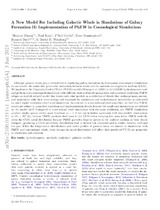| dc.contributor.author | Huang, Shuiyao | |
| dc.contributor.author | Katz, Neal | |
| dc.contributor.author | Dave, Romeel | |
| dc.date.accessioned | 2021-08-31T17:08:57Z | |
| dc.date.available | 2021-08-31T17:08:57Z | |
| dc.date.issued | 2021 | |
| dc.identifier.citation | Huang et al., 2020. A new model for including galactic winds in simulations of galaxy formation – I. Introducing the Physically Evolved Winds (PhEW) model. Monthly Notices of the Royal Astronomical Society, 497(3), pp.2586-2604. | en_US |
| dc.identifier.uri | http://hdl.handle.net/10566/6569 | |
| dc.description.abstract | Although galactic winds play a critical role in regulating galaxy formation, hydrodynamic cosmological simulations
do not resolve the scales that govern the interaction between winds and the ambient circumgalactic medium (CGM).
We implement the Physically Evolved Wind (PhEW) model of Huang et al. (2020) in the GIZMO hydrodynamics code
and perform test cosmological simulations with different choices of model parameters and numerical resolution. PhEW
adopts an explicit subgrid model that treats each wind particle as a collection of clouds that exchange mass, metals,
and momentum with their surroundings and evaporate by conduction and hydrodynamic instabilities as calibrated
on much higher resolution cloud scale simulations. In contrast to a conventional wind algorithm, we find that PhEW
results are robust to numerical resolution and implementation details because the small scale interactions are defined
by the model itself. Compared to conventional wind simulations with the same resolution, our PhEW simulations
produce similar galaxy stellar mass functions at z ≥ 1 but are in better agreement with low-redshift observations
at M∗ < 1011M⊙ because PhEW particles shed mass to the CGM before escaping low mass halos. PhEW radically
alters the CGM metal distribution because PhEW particles disperse metals to the ambient medium as their clouds
dissipate, producing a CGM metallicity distribution that is skewed but unimodal and is similar between cold and
hot gas. While the temperature distributions and radial profiles of gaseous halos are similar in simulations with
PhEW and conventional winds, these changes in metal distribution will affect their predicted UV/X-ray properties
in absorption and emission. | en_US |
| dc.language.iso | en | en_US |
| dc.publisher | Monthly Notices of the Royal Astronomical Society | en_US |
| dc.subject | hydrodynamics | en_US |
| dc.subject | methods: analytical | en_US |
| dc.subject | galaxies: outflow | en_US |
| dc.title | A New Model For Including Galactic Winds in Simulations of Galaxy Formation II: Implementation of PhEW in Cosmological Simulations | en_US |
| dc.type | Article | en_US |

